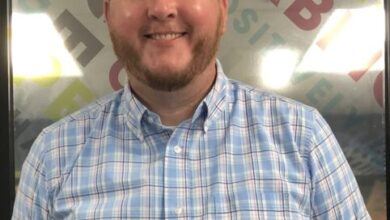 This month’s interview is with Justin Pate, owner of The Wrap Institute.
This month’s interview is with Justin Pate, owner of The Wrap Institute.
What path brought you to installing wraps for a career and becoming one of the world’s most well-known instructors?
I just happened into it. In 1996, an upstairs neighbor who was an installer in New York City asked me to come work for him for a week. I tried it out and fell in love. The combination that wrapping was physical yet focused mentally plus being able to transform plain objects with amazing designs in a day just resonated with me.
Who are some people you learned from or would consider mentors who helped you get to where you are in your career?
My wife Beertje first and foremost, as she has been extremely supportive of my career. Also, being a great writer, she was instrumental in teaching me how to explain a lot with less words. Simple and easy to understand takes a lot of time to learn how to do. Paul Roba from Avery Dennison gave me my big break years ago in letting me head the workshop and certification program. My partner Scott Bechtel from Car Wrap City has been a tremendous help and Frank Fellers gave The Wrap Institute a lot of support early on, which gave me confidence to know that I was on to something.
You’ve been training people to install vinyl for many years. What have been the most drastic changes in the wraps industry since you began teaching?
I think the two biggest changes to the wrap industry are tools and the internet. There are way more tools that are specifically focused on wrapping that simply weren’t there 10 years ago. Knifeless Tape being a big example. The internet has made installers better in that they have more knowledge and access to seeing techniques. I think the internet also comes with a shadow because people post items that are overwrapped and then other installers think that is the norm. This can lead to slow installs and low profits, so it’s been something I have been trying to clarify on The Wrap Institute and in workshops.
As you grade your students or as you judge vehicle wrap competitions, what are the first things you notice about an installation that will tell you if the wrap is done correctly?
The workspace reflects the wrap. I don’t think I have ever seen an exception to this. If the tools and trash are lying on the floor during and after the install without a doubt there will be wrinkled corners, loose edges, squeegee marks and hand prints. Keeping a clean, professional workspace almost always results in a pass.
What are some bad habits you see in students that you try to train them away from in your classes?
The main bad habit that I try to correct is going for the heat gun or propane torch as soon as they see wrinkles. Heating the film does relax the wrinkles but it takes time to do and often it leads to overstretching the film. I emphasize that the best way to get wrinkles out is with a combination of the triangle technique, relief cuts, shooting for the corners and having a thin buffer. More often than not, heat should only be used for a few seconds to relax an edge or corner before cutting. Once a student wraps their head around this logic, I see their install time drop in half.
What is your favorite wrap installation you’ve ever done, and why does that one stand out?
One time I wrapped 90 full-print cars in 22 days with one other installer, Shad Interligi from Real Hit Media. This was my biggest fleet up to that point, and it had the right elements that catered to how I like to wrap, which is speedwrapping: all cars under one roof, all the graphics printed ahead of time, the right material, etc. Just pure focus and high workflow. To see all the cars lined up at the end for a photo was really satisfying. Keep in mind that they were on for three years and not one call to complain of lifting – who cares if the cars are wrapped fast if they don’t last.
You have 200 hours’ worth of training videos on your website, wrapinstitute.com. What goes into filming each of those videos?
It’s a combination of planning and being open to ideas while filming. I have a set plan of making instructional and product videos that I incorporate into a 3-4 day shoot. The cameraman can flow with me so it’s about just going from one story to the next while improvising in new ideas. It’s a lot to think about while filming but, since I am the editor, it works on all levels. I tried using an editor to make them, but they aren’t wrappers so it’s hard for them to see the storyline. In fact, sometimes I hire wrappers to be the cameraman because they can anticipate my next move, which is key as I really go for close-ups.
If you could convince car manufacturers to stop making one car because of its difficulty to wrap, what would it be?
Like I said in a speech two years ago at a conference in Amsterdam, I want all car manufacturers to go back to the Model T Ford – all black. This is the perfect pallet for wrapping a car. I don’t care about curves, angles and corners since I teach so many ways to wrap these. It’s the color I can control. Making the cars black would simplify their manufacturing process while making the wrapping, especially color change, a breeze. I think Henry Ford was a century too early. Hopefully Elon Musk is reading this.




